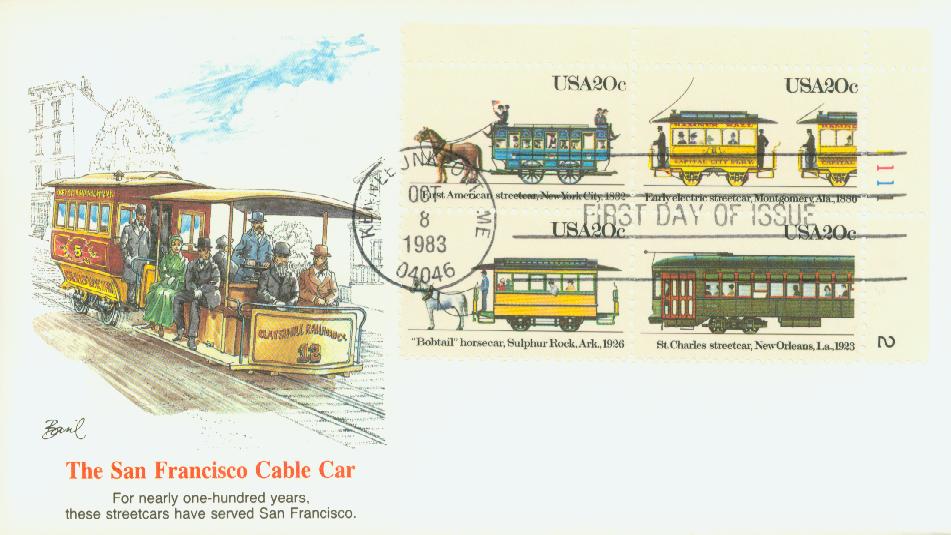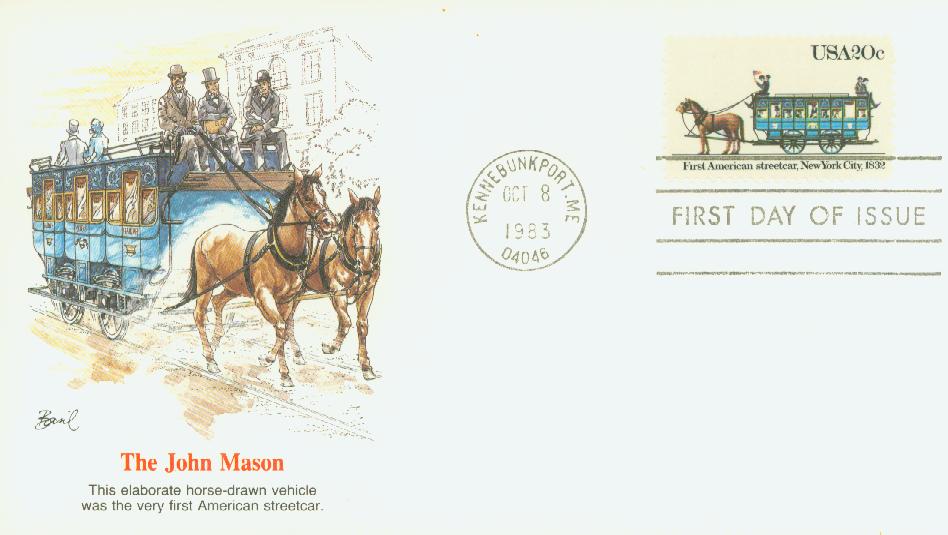
# 2059 FDC - 1983 20c Street Cars: First American, 1832
Â
20¢ First American Streetcar
Street Cars
City: Kennebunkport, ME
Quantity: 51,931,250
Printed By: Bureau of Engraving and Printing
Printing Method: Photogravure and engraved
Perforations: 11
Color: Multicolored
First Streetcar In America
One man dominated the history of streetcars in America in the early days of their use. John Stephenson developed the first streetcar to run on rails. In general, he presided over the evolution of streetcars as public transportation.

Stephenson was an infant when his family immigrated to America in 1811. He grew up in New York City and went to college in Connecticut. A few years after Stephenson graduated, he started his own company of building “omnibuses†– horse-drawn passenger vehicles. Stephenson had worked as an apprentice under Abram Brower before striking out on his own.
It was a job order from banker John Mason that was Stephenson’s first big break. Mason wanted a passenger vehicle for a route for the New York and Harlem Railroad. Stephenson’s car was based on a modified English railway car. It ran on rails, making it a much more comfortable ride than the typically rough roads provided, and eventually earned him a sales contract. He named the car the John Mason, in honor of the man who commissioned it.

The John Mason officially went into service on November 14, 1832. It was popular from the start, considered a luxurious upgrade from the omnibus. It was more comfortable, beautifully upholstered, and could travel nearly twice the speed (6-8 miles per hour) with fewer horses. It was also more efficient, so it cost 10¢ per ride compared to the 15¢ per ride on the omnibus. By 1870, horse-drawn streetcars had made nearly 100 million trips a year.

Stephenson went on to build other famous streetcars, including the St. Charles car, famous for its use in New Orleans. Another was the Bobtail, a lightweight, mule-drawn car used in Sulphur Rock, Arkansas, which in 1889 was the last animal-drawn car to be used in the US on a regular basis.
There is another neat story about Stephenson and his ethics. In 1837, an economic panic hit the country as bank-issued bonds were often used to back currency, and then became worthless when many banks failed to honor them. Stephenson had accepted a lot of payment in bonds, and lost all his property by 1842. He could only pay his creditors 50 cents on the dollar. He began again, and within a few years had repaid all his creditors in full, earning the nickname, “Honest John Stephenson.â€

The John Mason, the St. Charles, and the Bobtail were all featured on the 1983 Street Cars stamps above. The fourth stamp pictures an Electric Trolley Car, which was used in Montgomery, Alabama, in 1886. It eventually served all of Montgomery, becoming the first citywide electrical streetcar system in the world.
Â
20¢ First American Streetcar
Street Cars
City: Kennebunkport, ME
Quantity: 51,931,250
Printed By: Bureau of Engraving and Printing
Printing Method: Photogravure and engraved
Perforations: 11
Color: Multicolored
First Streetcar In America
One man dominated the history of streetcars in America in the early days of their use. John Stephenson developed the first streetcar to run on rails. In general, he presided over the evolution of streetcars as public transportation.

Stephenson was an infant when his family immigrated to America in 1811. He grew up in New York City and went to college in Connecticut. A few years after Stephenson graduated, he started his own company of building “omnibuses†– horse-drawn passenger vehicles. Stephenson had worked as an apprentice under Abram Brower before striking out on his own.
It was a job order from banker John Mason that was Stephenson’s first big break. Mason wanted a passenger vehicle for a route for the New York and Harlem Railroad. Stephenson’s car was based on a modified English railway car. It ran on rails, making it a much more comfortable ride than the typically rough roads provided, and eventually earned him a sales contract. He named the car the John Mason, in honor of the man who commissioned it.

The John Mason officially went into service on November 14, 1832. It was popular from the start, considered a luxurious upgrade from the omnibus. It was more comfortable, beautifully upholstered, and could travel nearly twice the speed (6-8 miles per hour) with fewer horses. It was also more efficient, so it cost 10¢ per ride compared to the 15¢ per ride on the omnibus. By 1870, horse-drawn streetcars had made nearly 100 million trips a year.

Stephenson went on to build other famous streetcars, including the St. Charles car, famous for its use in New Orleans. Another was the Bobtail, a lightweight, mule-drawn car used in Sulphur Rock, Arkansas, which in 1889 was the last animal-drawn car to be used in the US on a regular basis.
There is another neat story about Stephenson and his ethics. In 1837, an economic panic hit the country as bank-issued bonds were often used to back currency, and then became worthless when many banks failed to honor them. Stephenson had accepted a lot of payment in bonds, and lost all his property by 1842. He could only pay his creditors 50 cents on the dollar. He began again, and within a few years had repaid all his creditors in full, earning the nickname, “Honest John Stephenson.â€

The John Mason, the St. Charles, and the Bobtail were all featured on the 1983 Street Cars stamps above. The fourth stamp pictures an Electric Trolley Car, which was used in Montgomery, Alabama, in 1886. It eventually served all of Montgomery, becoming the first citywide electrical streetcar system in the world.










